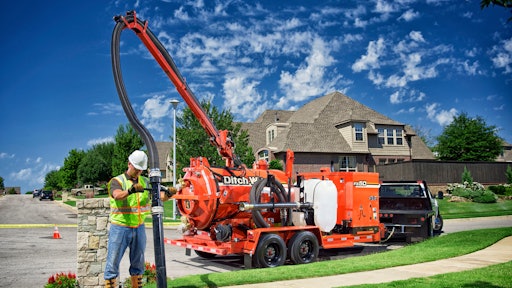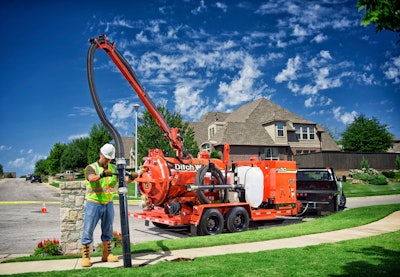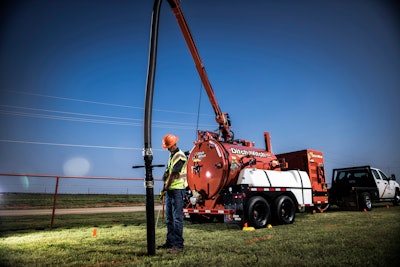
As the underground utility network becomes increasingly more complex and congested, construction professionals know that there is no room for error. Working on compact jobsites with winding utilities can make for a difficult environment, which is why some landscapers are turning to vacuum excavators for a variety of green industry tasks.
What was once thought of as only a machine for HDD jobsites, vacuum excavators are now popping up all over landscaping jobsites. These machines help landscapers excavate near sensitive areas and in areas where traditional methods are unable to get the job done. Including damage prevention for utility installation and cleaning out gardens and flower beds, vacs are quickly becoming a versatile and noninvasive digging solution in the industry.
When used correctly, vacuum excavators offer a lot of benefits to landscaping jobsites. Here are three areas to consider when thinking about adding a vacuum excavator to your green industry fleet. Vacs are quickly becoming a versatile and noninvasive solution in the green industry.Ditch Witch
Vacs are quickly becoming a versatile and noninvasive solution in the green industry.Ditch Witch
A crowded jobsite work-around
Today’s jobsites are rarely simple, especially residential jobs. Above ground, they are filled with fences, sheds, existing landscaping, gardens, trees and other potential hazards. Below ground, they are congested with existing utilities that operators must avoid striking. A vacuum excavator offers a more flexible, less invasive option.
Trenching near a structure or fence, especially when starting or finishing a trench against one of these existing structures, can be particularly difficult with a large trencher. In locations where trenchers can’t reach, landscapers can use their vac to open the trench. On jobsites with space restrictions, landscapers can park their vacuum excavator up to 100 feet away from the trench location and reach the site with their vac wand. This flexibility simplifies the trenching task for operators and helps mitigate any potential damage to existing structures. Residential jobs can be difficult because of all the potential surrounding hazards.Ditch Witch
Residential jobs can be difficult because of all the potential surrounding hazards.Ditch Witch
Exposing underground
With their ease-of-use, high return on investment and soft-excavation style, vacuum excavators are growing in popularity. For landscape professionals who are constantly needing to expose underground infrastructure or conduct earthmoving tasks for landscaping, a vacuum excavator is a versatile tool to add to the fleet.
Vacuum excavators are ideally designed for soft excavation practices like utility exposure, a good choice for damage mitigation. Contractors should always keep their nozzle 8 inches away from the utility to prevent damage to both the equipment and utility, and water pressure should be kept below 2,800 psi and 200 psi for air excavation with the nozzle consistently moving when actively excavating. These best practices will allow for the most efficient and safe excavation and help contractors expose utilities more easily.
Today, most equipment manufacturers design vacuum excavators with both air and hydro-excavation capabilities, so operators don’t have to choose between the two. Contractors can start excavating the ground surface with air and switch to hydro once they reach harder soil formations. Landscape professionals have the potential to work on jobsites formed of anything, including clay and topsoil, so this versatility and knowing when to adjust for damage mitigation are crucial. Rather than adjusting pressure, if operators are struggling to excavate through hard soil or heavy clay, they should use a hot water heater instead of moving the nozzle closer. With the versatility to switch from hydro to air, operators can better adapt to changing jobsite conditions and stay productive in a variety of ground conditions. For landscape professionals who are constantly needing to expose underground infrastructure or conduct earthmoving tasks for landscaping, a vacuum excavator is a versatile tool to add to the fleet.Ditch Witch
For landscape professionals who are constantly needing to expose underground infrastructure or conduct earthmoving tasks for landscaping, a vacuum excavator is a versatile tool to add to the fleet.Ditch Witch
Everything in between
In addition to exposing utilities or finishing a trench, a vac can help landscapers with more specialized or niche tasks such as working in a flower garden or mulch bed. By using the suction tool of the excavator, landscapers can remove and clear out old mulch and debris without the worry of damaging homeowners’ flowers, grass or well-cultivated vegetation.
Vacs can also be used for tree installation and growth stimulation. Whether installing a young 5-foot tree or maintaining a mature 20-foot tree, vacs can help loosen up the soil to create a more stable root foundation and encourage proper root grow out. This can help landscapers and arborists save on time and labor and can reduce surface disruption in the excavation process.
The versatility of vacs and their ability to conquer a wide array of tasks less invasively is why they are growing in popularity. With these machines in their fleet, landscapers can stay safe, agile and efficient on a variety of tasks while maximizing jobsite uptime and minimizing downtime.
When used correctly vacuum excavators are a great asset that can improve a landscaper’s versatility and reduce the likelihood of causing damage to yards, structures, existing utilities and landscaping.



























